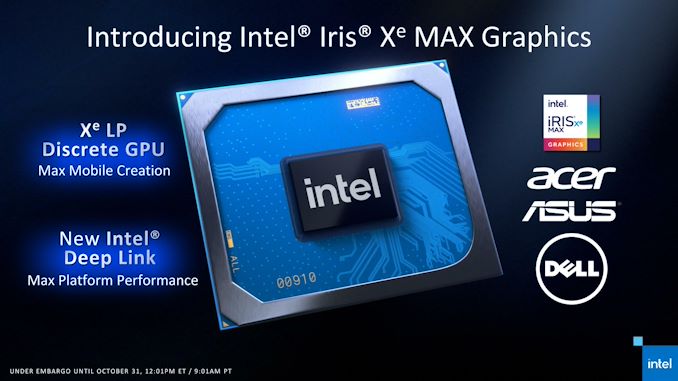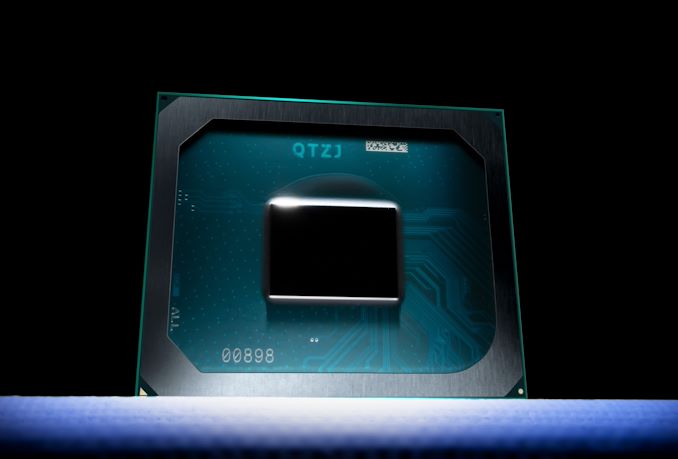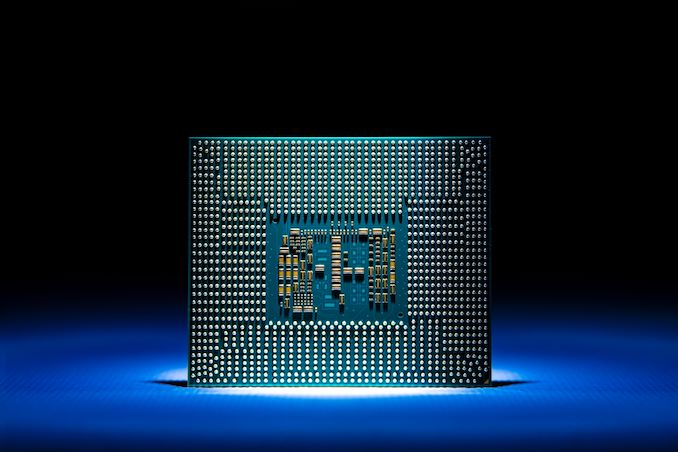Intel’s Discrete GPU Era Begins: Intel Launches Iris Xe MAX For Entry-Level Laptops
by Ryan Smith on October 31, 2020 12:01 PM EST
Today may be Halloween, but what Intel is up to is no trick. Almost a year after showing off their alpha silicon, Intel’s first discrete GPU in over two decades has been released and is now shipping in OEM laptops. The first of several planned products using the DG1 GPU, Intel’s initial outing in their new era of discrete graphics is in the laptop space, where today they are launching their Iris Xe MAX graphics solution. Designed to complement Intel’s Xe-LP integrated graphics in their new Tiger Lake CPUs, Xe MAX will be showing up in thin-and-light laptops as an upgraded graphics option, and with a focus on mobile creation.
We’ve been talking about DG1 off and on since CES 2020, where Intel first showed off the chip in laptops and in a stand-alone development card. The company has continuously been coy about the product, but at a high level it’s been clear for some time that this was going to be an entry-level graphics solution suitable for use in smaller laptops. Based heavily on the integrated graphics in Intel’s Tiger Lake-U CPU, the Xe-LP architecture GPU is a decidedly entry-level affair. None the less, it’s an important milestone for Intel: by launching their first DG1-based product, Intel has completed first step in their plans to establish themselves as a major competitor in the discrete GPU space.
Sizing up Intel’s first dGPU in a generation, Intel has certainly made some interesting choices with the chip and what markets to pursue. As previously mentioned, the chip is based heavily on Tiger Lake-U’s iGPU – so much so that it has virtually the same hardware, from EUs to media encoder blocks. As a result, Xe MAX isn’t as much a bigger Xe-LP graphics solution so much as it is an additional discrete version of the Tiger Lake iGPU. Which in turn has significant ramifications in the performance expectations for the chip, and how Intel is going about positioning it.
To cut right to the chase on an important question for our more technical readers, Intel has not developed any kind of multi-GPU rendering technology that allows for multiple GPUs to be used together for a single graphics task (ala NVIDIA’s SLI or AMD’s CrossFire). So there is no way to combine a Tiger Lake-U iGPU with Xe MAX and double your DOTA framerate, for example. Functionally, Xe MAX is closer to a graphics co-processor – literally a second GPU in the system.
As a result, Intel isn’t seriously positioning Xe MAX as a gaming solution – in fact I’m a little hesitant to even attach the word “graphics” to Xe MAX, since Intel’s ideal use cases don’t involve traditional rendering tasks. Instead, intel is primarily pitching Xe MAX as an upgrade option for mobile content creation; an additional processor to help with video encoding and other tasks that leverage GPU-accelerated computing. This would be things like Handbrake, Topaz’s Gigapixel AI image upsampling software, and other such productivity/creation tasks. This is a very different tack than I suspect a lot of people were envisioning, but as we’ll see, it’s the route that makes the most sense for Intel given what Xe MAX can (and can’t) do.
At any rate, as an entry-level solution Xe MAX is being setup to compete with NVIDIA’s last-generation entry-level solution, the MX350. Competing with the MX350 is a decidedly unglamorous task for Intel’s first discrete graphics accelerator, but it’s an accurate reflection of Xe MAX’s performance capabilities as an entry-level part, as well as a ripe target since MX350 is based on last-generation NVIDIA technology. NVIDIA shouldn’t feel too threatened since they also have the more powerful MX450, but Xe MAX has a chance to at least dent NVIDIA’s near-absolute mobile marketshare by going after the very bottom of it. And, looking at the bigger picture here for Intel’s dGPU efforts, Intel needs to walk before they can run.
Finally, as mentioned previously, today is Xe MAX’s official launch. Intel has partnered with Acer, ASUS, and Dell for the first three laptops, most of which were revealed early by their respective manufacturers. These laptops will go on sale this month, and the fact that today’s launch was timed to align with midnight on November 1st in China offers a big hint of what to expect. Intel’s partners will be offering Xe MAX laptops in China and North America, but given China’s traditional status as the larger, more important market for entry-level hardware, don’t be too surprised if that’s where most Xe MAX laptops end up selling, and where Intel puts its significant marketing muscle.
| Intel GPU Specification Comparison | ||||||
| Iris Xe MAX dGPU |
Tiger Lake iGPU |
Ice Lake iGPU |
Kaby Lake iGPU |
|||
| ALUs | 768 (96 EUs) |
768 (96 EUs) |
512 (64 EUs) |
192 (24 EUs) |
||
| Texture Units | 48 | 48 | 32 | 12 | ||
| ROPs | 24 | 24 | 16 | 8 | ||
| Peak Clock | 1650MHz | 1350MHz | 1100MHz | 1150MHz | ||
| Throughput (FP32) | 2.46 TFLOPs | 2.1 TFLOPs | 1.13 TFLOPs | 0.44 TFLOPs | ||
| Geometry Rate (Prim/Clock) |
2 | 2 | 1 | 1 | ||
| Memory Clock | LPDDR4X-4266 | LPDDR4X-4266 | LPDDR4X-3733 | DDR4-2133 | ||
| Memory Bus Width | 128-bit | 128-bit (IMC) |
128-bit (IMC) |
128-bit (IMC) |
||
| VRAM | 4GB | Shared | Shared | Shared | ||
| TDP | ~25W | Shared | Shared | Shared | ||
| Manufacturing Process | Intel 10nm SuperFin | Intel 10nm SuperFin | Intel 10nm | Intel 14nm+ | ||
| Architecture | Xe-LP | Xe-LP | Gen11 | Gen9.5 | ||
| GPU | DG1 | Tiger Lake Integrated |
Ice Lake Integrated | Kaby Lake Integrated | ||
| Launch Date | 11/2020 | 09/2020 | 09/2019 | 01//2017 | ||
Kicking off the deep dive portion of today’s launch, let’s take a look at the specs for the Xe MAX. As previously mentioned, Xe MAX is derived from Tiger Lake’s iGPU, and this is especially obvious when looking at the GPUs side-by-side. Xe-LP as an architecture was designed to scale up to 96 EUs; Intel put 96 EUs in Tiger Lake, and so a full DG1 GPU (and thus Xe MAX) gets 96 EUs as well.
In fact Xe MAX is pretty much Tiger Lake’s iGPU in almost every way. On top of the identical graphics/compute hardware, the underlying DG1 GPU contains the same two Xe-LP media encode blocks, the same 128-bit memory controller, and the same display controller. Intel didn’t even bother to take out the video decode blocks, so DG1/Xe MAX can do H.264/H.265/AV1 decoding, which admittedly is handy for doing on-chip video transcoding.
And, to be sure, Intel has confirmed that DG1 is a real, purpose-built discrete GPU. So Xe MAX is not based on salvaged Tiger Lake CPUs or the like; Intel is minting discrete GPUs just for the task. As is usually the case, Intel is not disclosing die sizes or transistor counts for DG1. Our own best guess for the die size is an incredibly rough 72mm2, and this is based on looking at how much of Tiger Lake-U’s 144mm2 die is estimated to occupied by GPU blocks. In reality, this is probably an underestimate, but even so, it’s clear that DG1 is a rather petite GPU, thanks in part to the fact that it’s made on Intel’s 10nm SuperFin process.
Overall, given the hardware similarities, the performance advantage that Xe MAX has over Tiger Lake’s iGPU is that the discrete adapter gets a higher clockspeed. Xe MAX can boost to 1.65GHz, whereas the fastest Tiger Lake-U SKUs can only turbo to 1.35GHz. That means all things held equal, the discrete adapter has a 22% compute and rasterization throughput advantage on paper. But since we’re talking about laptops, TDPs and heat management are going to play a huge role in how things actually work.
Meanwhile the fact that Xe MAX gets Tiger Lake’s memory controller makes for an interesting first for a discrete GPU: this is the first stand-alone GPU with LPDDR4X support. Intel’s partners will be hooking up 4GB of LPDDR4X-4266 to the GPU, which with its 128-bit memory bus will give it a total memory bandwidth of 68GB/sec. Traditionally, entry-level mobile dGPUs use regular DDR or GDDR memory, with the latter offering a lot of bandwidth even on narrow memory buses, but neither being very energy efficient. So it will be interesting to see how Xe MAX’s total memory power consumption compares to the likes of the GDDR5/64-bit MX350.
As an added bonus on the memory front, because this is a discrete GPU, Xe MAX doesn’t have to share its memory bandwidth with other devices. The GPU gets all 68GB/sec to itself, which should improve real-world performance.
And since Xe MAX is a discrete adapter, it also gets its own power budget. The part is nominally 25W, but like TDPs for Intel’s Tiger Lake CPUs, it’s something of an arbitrary value; in reality the chip has as much power and thermal headroom to play with as the OEMs grant it. So an especially thin-and-light device may not have the cooling capacity to support a sustained 25W, and other devices may exceed that during turbo time. Overall we’re not expecting any more clarity here than Intel and its OEMs have offered with Tiger Lake TDPs.
Last but not least, let’s talk about I/O. As an entry-level discrete GPU, Xe MAX connects to its host processor over the PCIe bus; Intel isn’t using any kind of proprietary solution here. The GPU’s PCIe controller is fairly narrow with just a x4 connection, but it supports PCIe 4.0, so on the whole it should have more than enough PCIe bandwidth for its performance level.
Meanwhile the part offers a full display controller block as well, meaning it can drive 4 displays over HDMI 2.0b and DisplayPort 1.4a at up to 8K resolutions. That said, based on Intel’s descriptions it sounds like most (if not all) laptops are going to be taking an Optimus route, and using Tiger Lake’s iGPU to handle driving any displays. So I’m not expecting to see any laptops where Xe MAX’s display outputs are directly wired up.














118 Comments
View All Comments
Spunjji - Sunday, November 1, 2020 - link
I hate the "AMD drivers suck" mantra more than most, but it's a fact that they repeatedly screwed things up with their mobile APUs. My understanding is that the situation has improved but is still not ideal.Intel CPU drivers suck, though, for sure. They rarely crash the system, but they're bug ridden.
ozzuneoj86 - Saturday, October 31, 2020 - link
Serious question:How many people own a laptop with this level of graphics? Maybe it's just because I search for "deals" rather than specific models, but I hardly ever see a laptop with low end discreet graphics that I would consider a good deal. Generally I see good solid systems with the latest AMD or Intel CPUs with integrated graphics or affordable gaming systems with 1650-level graphics for surprisingly low prices.
Who actually needs just a little bit more performance than integrated, but doesn't want too much performance? Seems oddly specific... but Intel clearly knows what is worth investing in, so there must be more of a market for these than I think?
lmcd - Saturday, October 31, 2020 - link
The boost is entirely via memory bandwidth and thermal separation. A 1650 exceeds the thermal usage of even a 35W CPU. An MX450 does not most likely, and obviously an Xe max does not.This means that 2x a small, thin thermal solution can be allocated to 1 for the GPU, 1 for the CPU.
Spunjji - Saturday, October 31, 2020 - link
Prior to Ice Lake and Renoir, this was a moderately popular segment well-served by Nvidia. Pretty much "how much GPU can we fit into this space where once there could have been none".But Intel just went and made sure pretty much all upcoming ultrabooks will already have a competent iGPU thanks to Tiger (drivers notwithstanding), rendering this product nearly pointless.
Tomatotech - Saturday, October 31, 2020 - link
Not sure why Intel are going into discrete graphics.Their Optane tech had real advantages - all Intel had to do was actually implement it as properly tiered storage (a well-understood technology) for almost instant restarting / wake / hibernate / app startup. A few gig in every chip or mobo would be cheap at scale and Intel would be onto a winner. Instead they half-assed it.
Perhaps with this ‘content creation’ dGPU they’re making a play for phones, car sensors, smart device sensors etc, but it’s ferociously competitive and price sensitive. Otherwise, well, I don’t know. dGPU market is tiny for a company like Intel and desktops / laptops are a mature / shrinking market, especially if your name isn’t Apple.
Spunjji - Saturday, October 31, 2020 - link
They'll find plenty of OEMs to take these off then, and plenty of customers will end up with them - but IMHO it's all utterly pointless.JayNor - Saturday, October 31, 2020 - link
Intel's Xe gpus can use Optane... read their patent applications.Kevin G - Saturday, October 31, 2020 - link
Very meh on this. It is an important stepping stone for Intel releasing a discrete graphics card but feels late to market without anything really going for it.At ~72 mm^2, why not scale it upward to say 144 mm^2 or 288 mm^2 that'd be more performant? This really does feel like a TigerLake die with the x86 cores hacked off. Ditto for the idea of using the same memory controller as TigerLake. While there are some OEM benefits to sticking with LPDDR4X-4266 (same memory part for CPU and GPU), the lack of GDDR6 support is very surprising. Granted there can be a handful of benefits coupled with Tiger Lake (see Adaptix comments below), the big question is why would an OEM spend time/money on developing this for the advantages it gets on top of a higher bill of materials for the laptops? Intel would practically have to give these away for free
The ability to leverage multi-GPU with Tiger Lake is interesting but likely not enough to be competitive a step up in the nVidia or AMD's mobile line up. While everyone loves (and in many cases deservingly so) to make fun of AMD for poor drivers, Intel historically has been even worse. I'm hyper skeptical that Intel has a good multi-GPU solution working. I can see the marketing slides indicating a solid performance gains in raw FPS but I'd predict that it'll be a microstuttering mess. Doubly so if Intel were to release a dual Iris Xe MAX discrete gaming card for desktops down the road.
In defense of Intel a little bit, the Adaptix technology can be beneficial in terms of power/cooling in some scenarios based upon the laptop design. Thermally you have more silicon area that generates heat and thus less thermal density. IE it is easier to move the generated heat to the cooling solution which would result in lower aggregate system temperatures. Allowing the OEMs control over this is critical as the advantages to using Adaptix will be dependent upon the TigerLake + Iris XE Max Hyper Turbo Black Legendary Collector's Edition implementation. Intel does need to work with OEMs on this to not screw it up to avoid sub-optimal traps.
I will say that this chip does look promising for the encoding/transcoding niche. Intel has the parts to build an impressive replacement to their VCA lineup around this chip. While the usage of LPDDR4X-4266 isn't that great for gaming performance, an expected support for DDR4L to enable SO-DIMM slots does make it interesting as a data center part: you can work on huge data sets if you put in larger SO-DIMMs. Slapping four of these Iris Xe MAX Delux Gold Ti Special Limited Editions on a card, eight SO-DIMM slots with 256 GB would be a transcoding beast to chew through the most demanding 8K footage. Or take one of those chips, some SO-DIMM slots and pair with a high end Intel NIC and/or FPGA on the card makes things interesting for some niche applications. Intel really needs to execute here as these markets are niche but they are lucrative.
Oh, and Intel's marketing name need to figure out a better naming scheme.
lmcd - Saturday, October 31, 2020 - link
AMD's laptop iGPU drivers are substantially worse than their dGPU drivers. Intel took power from OEMs a while ago but AMD has not yet to the same degree. As someone who has had their AMD driver settings panel broken 3+ times by Windows update by an older driver than I previously had installed, I can promise you there is upside.supdawgwtfd - Saturday, October 31, 2020 - link
Uhhhh....The drivers are the same.
Has been for a while.
AMD took back control of their drivers from OEMs because the OEMs were NOT updating them ever.
I think you need to do some research before spouting more nonsense.